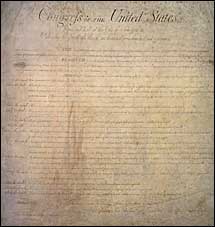|
The Bill of Rights
During the debates on the adoption of the Constitution, its
opponents repeatedly charged that the Constitution as drafted would
open the way to tyranny by the central government. Fresh in their
minds was the memory of the British violation of civil rights before
and during the Revolution. They demanded a "bill of rights" that
would spell out the immunities of individual citizens. Several state
conventions in their formal ratification of the Constitution asked
for such amendments; others ratified the Constitution with the
understanding that the amendments would be offered.
On September 25, 1789, the First Congress of the United States
therefore proposed to the state legislatures 12 amendments to the
Constitution that met arguments most frequently advanced against it.
The first two proposed amendments, which concerned the number of
constituents for each Representative and the compensation of
Congressmen, were not ratified. Articles 3 to 12, however, ratified
by three-fourths of the state legislatures, constitute the first 10
amendments of the Constitution, known as the Bill of Rights.
 |
 |
You can read transcriptions of:
|
Images of the Bill of Rights
Click the thumbnail below to view a larger version of the Bill of
Rights.
High-Resolution Images
High-Resolution versions of the Charters of Freedom documents
area available on the High-Resolution
Images page.
A Voice of Dissent: George Mason
 |
 |
As the delegates gathered at the Pennsylvania State House
in May 1787 to "revise" the Articles of Confederation,
Virginia delegate George Mason wrote, "The Eyes of the United
States are turned upon this Assembly and their Expectations
raised to a very anxious Degree." Mason had earlier written
the Virginia
Declaration of Rights that strongly influenced Thomas
Jefferson in writing the first part of the Declaration of
Independence. He left the convention bitterly disappointed,
however, and became one of the Constitution's most vocal
opponents. "It has no declaration of rights," he was to state.
Ultimately, George Mason's views prevailed. When James Madison
drafted the amendments to the Constitution that were to become
the Bill of Rights, he drew heavily upon the ideas put forth
in the Virginia Declaration of Rights. |
|
|
 |
|
More Resources
High-Resolution versions of the Charters of Freedom documents
area available on the High-Resolution
Images page.
The article "A
More Perfect Union" provides an in-depth look at the
Constitutional Convention, the ratification process, and the
adoption of the Bill of
Rights. |